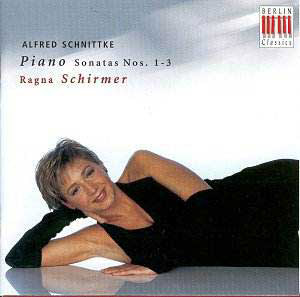By the time he completed his First Piano Sonata, Schnittke
had considerably modified his stylistic approach in that the polystylism
that informed many of his earlier works, had been cast off, or – at
least – drastically mastered, so that many of Schnittke’s later works
have a greater stylistic coherence. The music of the First Piano Sonata
is dark and introvert. The sonata was actually composed after the First
Cello Concerto and just before the intense, almost Mahlerian Fifth Symphony.
The music, in turn tense, dramatic, sometimes ironic (as in the second
movement), is serious, conveying some intense, personal emotions.
The Second Piano Sonata, dedicated to the composer’s
wife, Irina Katayeva, who gave the first performance in 1991, begins
almost innocently with a tender, romantic theme that progressively gains
in intensity until it reaches an abruptly cut-short climax after which
the music disintegrates into some unfathomable abyss. The slow movement
is a Sarabande in the form of a chorale and variations. The mostly
quick and nervous Finale restates the second movement’s chorale which
becomes brutally distorted as the music unfolds. It is torn to pieces.
Loud chords follow. The chorale tries to re-assert itself, but in vain.
The sonata ends in utter silence.
The Third Piano Sonata is the most substantial of the
three. It is in four movements: hesitant, isolated sounds slowly try
to find their way towards a restrained chorale that finally emerges
before receding into silence. There follows a hectic Scherzo with insistent
rhythms punctuated by clusters. The slow movement is a sorrowful, dark-hued
rêverie with some impassioned, short-lived outbursts, that
unfolds in simple counterpoint. The long Finale brings all main ideas
from the preceding movements into harsh conflict, ruthlessly interrupted
by angry clusters. The music here never really achieves any sort of
reconciliation but bluntly suffocates. No real Finale here.
Schnittke’s piano output is fairly limited, and the
three piano sonatas are his most substantial piano works as well as
some of his finest pieces. They share many common features with their
orchestral contemporaries, and clearly reflect the composer’s deepest
emotions and feelings at the time of writing. The music is often bleak,
austere though with some irony (the Third Piano Sonata may well be the
bleakest of the three); and Schnittke’s religious pre-occupations are
also reflected in the chorales that keep appearing in these otherwise
pessimistic works.
This release is, to the best of my knowledge, the only
one so far bringing Schnittke’s piano sonatas together. They make a
very coherent whole as such, both in terms of emotional content as well
of musical language. They all three are deeply serious works of substance
that repay closer examination and repeated hearings, especially in such
fine readings as those by Ragna Schirmer, which I find completely convincing.
Recommended.
Hubert Culot


